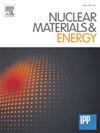聚变反应堆中具有氢氦分离能力的两级低温泵设计
IF 2.7
2区 物理与天体物理
Q1 NUCLEAR SCIENCE & TECHNOLOGY
引用次数: 0
摘要
在CFETR环面低温泵的再生过程中,将大部分未燃烧的燃料从解吸气体混合物中分离出来,可以提高燃料的回收效率。鉴于这种情况,本文基于活性炭涂层处理和未进行活性炭涂层处理的金属低温板对氢气、氦气和其他气体的低温吸附和冷凝能力的差异,提出了具有氢氦分离能力的两级低温泵概念。随后,对设计的低温泵进行了有限元仿真分析,包括热负荷、低温板温度和泵速。仿真结果表明,低温板的辐射热负荷相对均匀,验证了热屏蔽设计的有效性。在液氦(LHe)冷却条件下,低温板的平均温度稳定在5 K以下,具有良好的冷却性能。在分子流状态下,两级低温泵的最大抽速为35 m3/s,氢氦分离效率约为99%,从而验证了所提出的概念和设计的可行性。在设计分析的基础上,研制了两级低温泵样机,并搭建了试验平台,对其泵送性能进行了评价。试验结果表明,两级低温泵的抽速约为100 m3/s,基本满足核聚变反应堆导流器区低温泵的抽速要求。两级低温泵概念的提出和工程实现为未来聚变反应堆的氢氦分离和燃料快速循环提供了一条途径。本文章由计算机程序翻译,如有差异,请以英文原文为准。
Design of a two-stage cryopump with hydrogen-helium separation capability for fusion reactor application
During the regeneration process of the torus cryopumps in CFETR, separating the majority of unburned fuel from desorbed gas mixture can increase fuel recycling efficiency. Given this situation, this paper proposes a two-stage cryopump concept with hydrogen–helium separation capability, based on the differences in cryosorption and cryocondensation capabilities between metal cryopanels with and without activated charcoal coating treatments for hydrogen, helium, and other gases. Subsequently, finite element simulations were conducted to analyse parameters of the designed cryopump, including thermal load, cryopanel temperature, and pumping speed. The simulation results demonstrated that the radiative thermal load on the cryopanels was relatively uniform, confirming the effectiveness of the thermal shield design. Under liquid helium(LHe) cooling conditions, the average temperature of the cryopanels remained stable below 5 K, indicating excellent cooling performance. In the molecular flow regime, the two-stage cryopump achieved a maximum pumping speed of 35 m3/s with a hydrogen–helium separation efficiency of approximately 99 %, thereby validating the feasibility of the proposed concept and design. Based on the design and analysis, a prototype of the two-stage cryopump was developed, and a testing platform was established to evaluate its pumping performance. Test results revealed that the two-stage cryopump achieved a pumping speed of approximately 100 m3/s, which closely meets the expected pumping speed requirements for cryopumps in the divertor region of fusion reactors. The proposal and engineering implementation of the two-stage cryopump concept present an approach to the hydrogen–helium separation and rapid fuel cycling in future fusion reactor.
求助全文
通过发布文献求助,成功后即可免费获取论文全文。
去求助
来源期刊

Nuclear Materials and Energy
Materials Science-Materials Science (miscellaneous)
CiteScore
3.70
自引率
15.40%
发文量
175
审稿时长
20 weeks
期刊介绍:
The open-access journal Nuclear Materials and Energy is devoted to the growing field of research for material application in the production of nuclear energy. Nuclear Materials and Energy publishes original research articles of up to 6 pages in length.
 求助内容:
求助内容: 应助结果提醒方式:
应助结果提醒方式:


